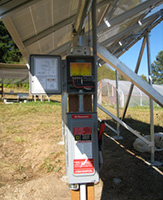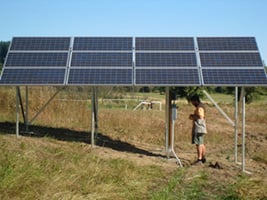Solar in Action
Solar Ambassadors are people who have gone before you and are willing to share their story. They will share with you their own experience installing solar, and share the good with the bad to give you a honest look at what to expect. Solar Ambassadors not only share their stories on our website, but they are also willing to talk to you about their experience.
Using micro-inverters in Medford



As the first solar system installed using micro-inverters in Jackson and Josephine Counties, the Brender-Rizvi family installed their 1.47 kW system in 2010. Each of the seven panels uses a micro-inverter instead of one large, centralized inverter. They believe that this helps make their system more productive, reliable and safer than traditional inverter systems.
Their 1938 home is located on a tree-lined old east Medford street, so putting up solar panels was not easy. In addition to installing a PV soar system, they own a hybrid car, dual flush high-efficiency toilets and a hybrid heat pump.
For questions, contact Mujahid Rizvi at ebrender@gmail.com.
Planning future additions in Bend



Built in 2009, this grid-tied solar system includes 10 2,000 watt SunTech roof-mounted panels and a PV-powered inverter. Their 1,600 square foot single-family home is relatively new and was built in 1993. The system was strategically designed and placed to allow for the addition of another PV and solar hot water system in the future.
For questions, contact Rod Page at 541.389.9712 or afterbyte@bendbroadband.com.
Community co-housing in Portland



Built in 2006, this community housing project fits four small housing on a conventional 1 ½ city-size lots in Portland. The community features include a salvaged lumber bike shed, a light straw-clay and cob guest house, a common courtyard, edible landscape and two eco-roofs. The solar hot water system provides about 2/3 of their annual electric needs and features a pre-heat, tankless hot water system and radiant in-floor heating.
The PV system is 2.85 kW includes 15 Sanyo 190 watt panels, which produces on average about 3,300 kWh a year. The hot water includes two Sun Early 33 square feet of collectors and an 80 gallon storage tank. The solar hot water system can get a boost from a Bradford-White Everhot gas-fired tankless water heater, which supplies all domestic hot water and in-floor radiant heat.
For questions, contact David Sweet at david@sabingreen.net.
Tackling roofing challenges in Portland


They said it couldn’t be done… Install solar panels on an east/west facing roof instead of the optimal south and west facing orientation. To complicate matters, the old Portland garage is flat. The vendor, Mr. Sun Solar, had to build a custom racking system. The homeowner had to shore up the garage to handle the extra 500 pounds, but spent less than $20 by purchasing lumber at the Rebuilding Center. Luckily, they used the sweat equity of neighbors. The 2.1 kW solar system was installed in 2007. Since the homeowners have a home business, they were able to receive additional incentives.
For questions, contact larkness@aol.com.
PV and drip irrigation in Yamhill County



Gaining Ground Farm’s US Department of Agriculture engineered DC powered irrigation system for crops is the first of its kind. During the day, irrigation water is pumped from a winter-harvested pond in our field (140 head feet) to four 2,500 gallon storage tanks. This 10,000 gallons of stored energy is held until evening, when we gravity feed the water back to the field through a 2 inch line, a filter bank and out to risers at the foot of every filed. The standing pressure at the filter bank is 40 psi. The risers then radiate across the base of the field with computerized valves spaced based on the size of the field and the type of crops. All fields now deliver water with drip irrigation, which is expected to result in a 50% savings in water use.
This area of farm in Yamhill County does not have grid available electricity and was cost prohibitive to install. In the past, the farm used high pressure, gas powered pumps and overhead sprinklers. Because the pumps were gas feed, we were only able to water during the day or at least when someone was available to fill the pumps. The sprinklers needed to be moved constantly and the pumps needed to be filled every two hours. The new system increases the efficiency of the system and reduces energy costs substantially. A 2.04 kW PV system was installed in 2010.
For questions, contact Mike Paine at 971-275-2842 or gaininggroundfarm@yahoo.com.
Off-grid and passive solar in Christmas Valley



Rabbit Dance Ranch began as a dream of self-sufficient living on 20 acres of unimproved land on the outskirts of Christmas Valley in central Oregon. Before installing solar energy, I read everything I could find on the internet about solar energy. My first solar installation was a composting toilet using a single solar panel. As I learned more, I moved on to installing a solar well pump with a back-up hand pump. Next I turned my attention to powering my 200 square foot yurt with two panels, and then added more as I could afford it making my yurt more self-sufficient and renewable. I now have enough solar panels and battery storage to keep my electricity running through the winter months without relying on my generator.
The yurt is wood framed with canvas covering. I have built earth bag solid walls around the yurt giving my home some passive solar heat by collecting the sun’s energy and releasing it at night. I am planning to build a passive solar water heater for summer use.
My solar heating system includes four panels totaling 540 watts, connected in a series and parallel to make a 24-volt system. I use a 60 amp Xantrex charge controller with a maximum power point tracking for increased efficiency, charging a bank of absorbed glass mat batteries totaling 560 amp-hours of storage allowing me to run power for several days without additional solar energy. From the batteries, I run a 900 watt inverter so I can use 110 volt appliances in the yurt. I run lights, a laptop computer, a printer and the internet dish from the yurt and will soon add a low-energy washing machine and microwave. I have a separate system for the well pump, which is 120 watts with a smaller charge controller and a 280 amp-hours of storage. It includes a pressure tank and switch to conserve energy and reduce wear on the pump. The 540 watt, 24 volt system was installed in 2010.
For questions, contact Carissa Kucera at 541-576-4039 or christmasvalleysolar@gmail.com.
Mega-mansion in Lakeview



Located in southern Oregon, our recycled mega-mansion was built in 2003. We installed 24 Astropower 120 watt panels in 2011. Our system includes a Midnight Solar combiner box, an Outback charge controller for 16 Rolls batteries divided into two 48 volt strings feeding a Trace Southwest 4840, 4,000 watt inverter connected to a positive disconnect switch. Our system is grid-connected to run a 220 volt water pump for fire protection and it serves as a back-up power system. We also have a 6 kW propane generator with auto switching to serves as backup to our solar PV panels. Since we are located in a remote area of the state, we use a variety of renewable resources in our home including the PV system, solar hot water heating, a wind generator, and a wood-fired outdoor water heater.
For questions, contact John Cogar at 541-417-1143 or eco-oregon@hotmail.com.
All-electric in Beaverton



The all electric 2,300 square foot house is located in Beaverton in the Highland Hills neighborhood, near two main intersections – Denney Road and Hall Boulevard. The house is perfectly suited for solar with a Total Solar Resource Fraction of 93%.
Eighteen years ago, we installed a solar water heating system that is still working. In 2009, we installed a 4.95 kW PV system and I’m amazed by how much energy the system generates. Since we are all-electric, it will never generate all of the electricity we need, but it does make a huge dent in our electric bill especially in the summer months.
Our system configuration includes 22 Solon panels with a Fronius IG Plus inverter. It was installed by SunWize Technologies. I had to install a new roof to qualify for the Energy Trust incentive. We will generate on average about 5,900 kW a year. If the cost of electricity doubles in 10 years (not likely at a national average of 3% a year), our system will pay back in less than nine years. This is almost as good as our solar hot water system, which has paid for itself at least twice over.
For questions, contact Dan and Kendal McDonald at dan.james.mcdonald@gmail.com.
An Accessible Remodeled Home
Max Woodbury and his family remodeled a 1923 Bungalow to accommodate a growing family and to ensure wheel chair access. Max shares his decision to go solar and how the solar electric works. The solar installation is a 2.8 KW system and is connected to the grid through net metering. Max also describes how solar system works including the inverter, panel hookup and net metering. The solar system has reduced their electric bill and added greater comfort to their home.
A New Green Home
Bob & Julie Granger had a new home built with many green features. They talk and demonstrate how their solar installation works. The solar installation is a 6 KW system and is connected to the grid through net metering. Bob Granger describes how solar system works including the inverter, panel hookup and net metering. The solar system has reduced their electric bill and added greater comfort to their home.
